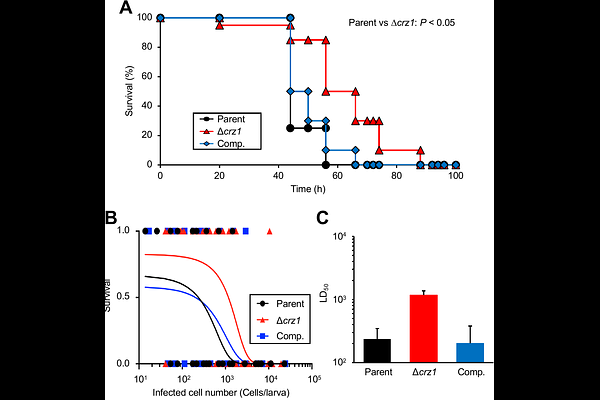Calcineurin-responsive zinc finger 1 (Crz1) contributes to stress tolerance and virulence in the pathogenic fungus Trichosporon asahii

Calcineurin-responsive zinc finger 1 (Crz1) contributes to stress tolerance and virulence in the pathogenic fungus Trichosporon asahii
Shimizu, Y.; Matsumoto, Y.; Sugita, T.
AbstractThe pathogenic fungus Trichosporon asahii causes severe invasive fungal infections in immunocompromised patients with neutropenia. In Cryptococcus neoformans, calcineurin-responsive zinc finger 1 (Crz1) functions as a transcription factor downstream of the calcineurin signaling pathway and regulates the expression of genes involved in stress resistance and virulence. In T. asahii, Cna1 and Cnb1, which are key components of the calcineurin pathway, contribute to various stress responses and virulence. The role of Crz1 in stress tolerance and virulence in T. asahii, however, has remained unclear. Here we demonstrate that a crz1 gene-deficient T. asahii mutant exhibited increased sensitivity to cell wall and endoplasmic reticulum stress. The crz1 gene-deficient mutant was sensitive to Congo red and tunicamycin, but not to dithiothreitol or sodium dodecyl sulfate. Moreover, the virulence of the crz1 gene-deficient mutant in the silkworm infection model was reduced. These phenotypes of the crz1 gene-deficient mutant were restored by reintroducing the crz1 gene, confirming the association between Crz1 and these phenotypes. The half maximal lethal dose of the cnb1 gene-deficient T. asahii mutant was higher than that of the crz1 gene-deficient mutant. These results suggest that Crz1 plays a role in mediating the stress responses and virulence of T. asahii. The involvement of Crz1 in the virulence of T. asahii is small, however, compared to that of the calcineurin.